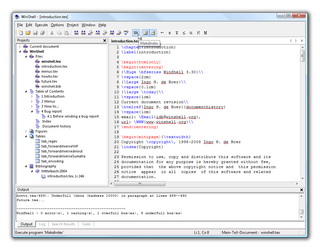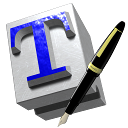
LaTeX is a software system for document preparation. When writing, the writer uses plain text as opposed to the formatted text found in WYSIWYG word processors like Microsoft Word, LibreOffice Writer and Apple Pages. The writer uses markup tagging conventions to define the general structure of a document, to stylise text throughout a document, and to add citations and cross-references. A TeX distribution such as TeX Live or MiKTeX is used to produce an output file suitable for printing or digital distribution.
TeX, stylized within the system as TeX, is a typesetting system which was designed and written by computer scientist and Stanford University professor Donald Knuth and first released in 1978. TeX is a popular means of typesetting complex mathematical formulae; it has been noted as one of the most sophisticated digital typographical systems.

Adobe FrameMaker is a document processor designed for writing and editing large or complex documents, including structured documents. It was originally developed by Frame Technology Corporation, which was bought by Adobe.

LyX is an open source, graphical user interface document processor based on the LaTeX typesetting system. Unlike most word processors, which follow the WYSIWYG paradigm, LyX has a WYSIWYM approach, where what shows up on the screen roughly depicts the semantic structure of the page and is only an approximation of the document produced by TeX.
OpenType is a format for scalable computer fonts. Derived from TrueType, it retains TrueType's basic structure but adds many intricate data structures for describing typographic behavior. OpenType is a registered trademark of Microsoft Corporation.

BibTeX is reference management software for formatting lists of references. The BibTeX tool is typically used together with the LaTeX document preparation system. Within the typesetting system, its name is styled as . The name is a portmanteau of the word bibliography and the name of the TeX typesetting software.

4DOS is a command-line interpreter by JP Software, designed to replace the default command interpreter COMMAND.COM in Microsoft DOS and Windows. It was written by Rex C. Conn and Tom Rawson and first released in 1989. Compared to the default, it has a large number of enhancements.

Xfig is a free and open-source vector graphics editor which runs under the X Window System on most UNIX-compatible platforms.

SciTE or SCIntilla based Text Editor is a cross-platform text editor written by Neil Hodgson using the Scintilla editing component. It is licensed under a minimal version of the Historical Permission Notice and Disclaimer.

WinShell is a freeware, closed-source multilingual integrated development environment (IDE) for LaTeX and TeX for Windows.

Far Manager is an orthodox file manager for Microsoft Windows and is a clone of Norton Commander. Far Manager uses the Win32 console and has a keyboard-oriented user interface.

WordPad is a word processor software included with Windows 95 and later, until Windows 11. Similarly to its predecessor Microsoft Write, it is a basic word processor, positioned as more advanced than the Notepad text editor by supporting rich text editing, but with a subset of the functionality of Microsoft Word.
MiKTeX is a free and open-source distribution of the TeX/LaTeX typesetting system for Microsoft Windows. It also contains a set of related programs. MiKTeX provides the tools necessary to prepare documents using the TeX/LaTeX markup language, as well as a simple TeX editor: TeXworks. The name comes from Christian Schenk's login: MiK for Micro-Kid.

XeTeX is a TeX typesetting engine using Unicode and supporting modern font technologies such as OpenType, Graphite and Apple Advanced Typography (AAT). It was originally written by Jonathan Kew and is distributed under the X11 free software license.
A number of vector graphics editors exist for various platforms. Potential users of these editors will make a comparison of vector graphics editors based on factors such as the availability for the user's platform, the software license, the feature set, the merits of the user interface (UI) and the focus of the program. Some programs are more suitable for artistic work while others are better for technical drawings. Another important factor is the application's support of various vector and bitmap image formats for import and export.

Cambria is a transitional serif typeface commissioned by Microsoft and distributed with Windows and Office. It was designed by Dutch typeface designer Jelle Bosma in 2004, with input from Steve Matteson and Robin Nicholas. It is intended as a serif font that is suitable for body text, that is very readable printed small or displayed on a low-resolution screen and has even spacing and proportions.
Beamer is a LaTeX document class for creating presentation slides, with a wide range of templates and a set of features for making slideshow effects.

Texmaker is a cross-platform open-source LaTeX editor with an integrated PDF viewer. It is entirely a Qt app. Texmaker supports Linux, macOS and Windows systems and integrates many tools needed to develop documents with LaTeX.

TeXworks is free and open-source application software, available for Windows, Linux and macOS. It is a Qt-based graphical user interface to the TeX typesetting system and its LaTeX, ConTeXt, and XeTeX extensions. TeXworks is targeted at direct generation of PDF output. It has a built-in PDF viewer using the poppler library; the viewer has auto-refresh capability, and also features SyncTeX support.










